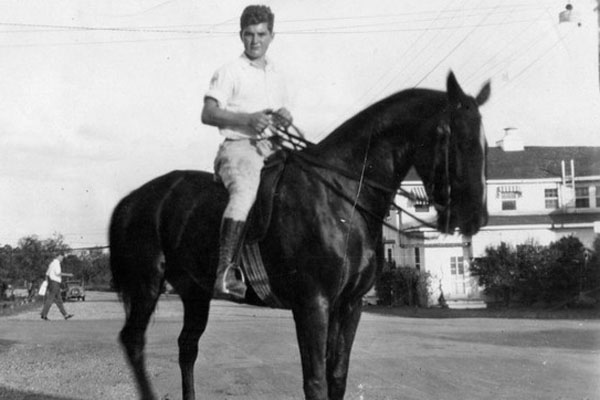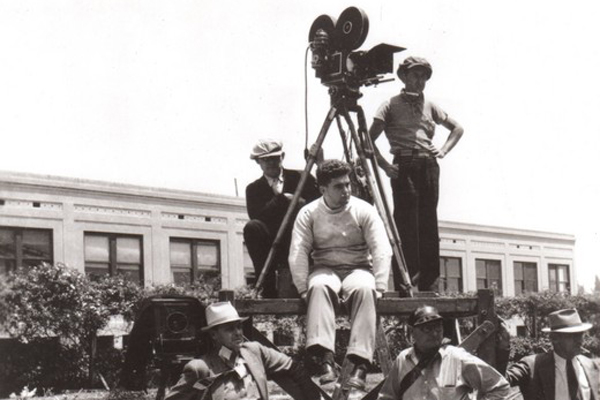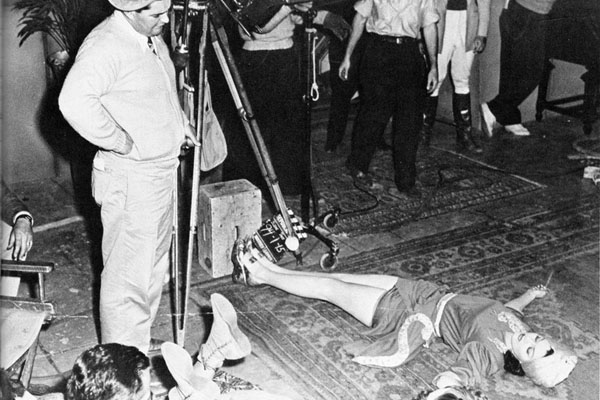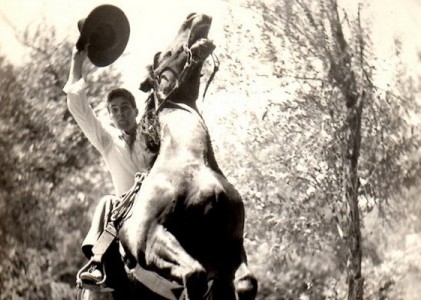William Witney, B-Movie Action King
Film director William Witney changed the way movie punches were thrown.
It has become a cliché to say that fight scenes are like dances, but for Witney
this was just common sense. He saw Busby Berkeley working on a stage
spectacle, and adapted that regimented method to action sequences, essentially
inventing the job of stunt choreographer. Witney honed this approach over a forty-year career directing an astonishing variety of low-budget action movies, from
1930s adventure serials to 1970s Blaxploitation comedies. A lifetime of B-movie
production had left him rather unknown, except to some cult genre obsessives, one
of whom happened to be Quentin Tarantino. He has been promoting Witney’s work
for years by screening his personal 16mm and 35mm prints at film festivals and mentioning
his name whenever interviewers ask for influences. After Tarantino finished
shooting Django Unchained, he shipped
its prop dentist wagon to the Lone Pine Film History Museum in California.
Witney spent the majority of his career in the hills outside Lone Pine,
shooting Westerns in a week or two with Roy Rogers, creating a cohesive body of
work out of bodies tumbling to the ground.
William Witney was born in Lawton, Oklahoma in 1915. His father died when he
was four years old, and he was raised by his mother Grace and two older
sisters. William’s son Jay Dee Witney told me that William was “kind of heavy
as a boy,” so his mother shipped him to live with his Uncle Lou, who was an Army
captain at Fort Sam Houston. It was there that Witney learned how
to ride and jump horses, beginning his long love affair with animals, which
would culminate with his sympathetic work with Trigger in the Roy Rogers movies.
Animals in his films are not props, but fully-developed characters given
subplots of their own. Tarantino called him the “greatest director when it
comes to working with animals.”

Young William Witney
Witney was ready to follow his Uncle into the Armed Forces after high school,
and started cramming for the entrance exam to the Naval Academy at Annapolis. The
exam was administered in Los Angeles, so Witney moved in briefly with his
sister Frances and her husband Colbert “Bert” Clark. A director for
the Poverty Row studio Mascot, Bert asked William if he wanted to “work for a
couple of days making chase scenes with the cowboys.” Witney agreed, and after
a day’s riding alongside stuntmen Yakima Canutt and Ken Cooper, he would never
be far away from a saddle. Eventually Bert got him a job as an office boy at
Mascot, and when he failed the Math section of the Naval exam, he stayed on for
good. He gradually moved up the ranks, from office boy to gofer to editor, where
he worked alongside future B-auteur Joseph H. Lewis (Gun Crazy).
In 1935 Hubert Yates consolidated six Poverty Row studios, including Mascot,
into Republic Pictures. Witney would make nearly 80 features and serials for
Republic over the next 23 years. After some personnel shakeups the
nineteen-year-old Witney was moved from the editing suite to the set as a
script clerk. It was B. Reeves Eason (known as “Breezy”) that got him thinking
about action film aesthetics. He was a flamboyant dresser, always in white silk
shirts and pants, with a daredevil streak. In his autobiography Witney recalls
a story in which Breezy performed a dangerous horse fall to convince a skittish
stuntman of its safety, and ended up breaking an arm. Witney admired his
bravado and fearlessness, writing that “I found myself using the same
techniques that he had to make an action sequence come to reality.”
When the Dick Tracy (1937) serial was
falling behind schedule, Witney was asked to direct second-unit
location footage, and then to edit the footage himself. The low budgets
necessitated that employees become jacks of all trades, and Witney had
first-hand experience of every aspect of the filmmaking process by the time he
was twenty years old. So when one of the directors on The Painted Stallion (1937, a Western serial starring Ray “Crash”
Corrigan) was fired for his alcoholism, Witney was ready to step in. He was
reunited with Yakima Canutt, who performed the first stunt Witney filmed as
a director, flipping over a buckboard pulled by two horses. In chapter eight of The
Painted Stallion, The Whistling Arrow, they would perfect a stunt made famous by Canutt in Stagecoach (1939). Canutt (doubling for
Corrigan) chases down a breakaway stagecoach and falls in between the lead
horses, grabbing the wagon tongue to avoid being trampled. Then he loses his
grip and the wagon rolls over him, but before it gets away he snags a rope
dangling off the back and snaps himself up onto the coach and finally settles
the horses. It is an exhilarating sequence that works on pure velocity.
Witney would often shoot action scenes at 22 frames per second to create the
illusion of death-defying speed instead of the simply dangerous rate at which they were
actually moving. When Witney cuts in closer to the stunt, Canutt’s body
position is perfectly matched from shot to shot, so his motions appear to be one
unbroken ribbon of action. Witney used the Republic camera car for long
tracking shots aside the stagecoach, and over the years he would experiment
with how to best position it. In these early serials he would almost always
place the camera so it pointed perpendicular to the chase, the viewers watching
side saddle. By the time of the Roy Rogers Westerns in the 1940s, he had
switched to head-on angles, with the outlaws and heroes heading straight at the
camera, placing the audience directly in the line of fire.
The highlight of his next serial, S.O.S.
Coast Guard (1937), was meeting his future wife in actress Maxine Doyle.
The movie offered little opportunity for inventive stuntwork but plenty for the
Republic special effects crew. The insane script has villain Bela Lugosi wield
a “disintegrating gas” that was dramatized by using funhouse mirror optical
effects, with objects elongating into nothingness. Witney would only gain some
measure of directorial control when he teamed up with John English, his partner
on seventeen serials with Republic. English was a debonair Brit whom Witney
described as a “boudoir man.” Witney shot the outdoor and action scenes, and
English would handle the interiors. It was an ideal working relationship, but
they also became close friends—Witney asked English to be his son Jay Dee’s
godfather. Zorro Rides Again (1937)
is their debut collaboration, and acts as a compendium of pulp scenarios,
jumping from Western adventure to nighttime urban noir, leading to
technological collisions like when Zorro jumps from a horse to a moving truck
in order to chase down a train.

Director William Witney sits on the edge of the camera platform at Republic Pictures in Studio City, California, circa 1930s
It was around this time that Witney
watched Busby Berkeley at work, having been invited to the set by a friend who
was a Warner Brothers grip. Berkeley would rehearse one high leg kick until
“you could have shot a bullet down the line and not hit anyone,” and when he
released them to get into costume, he would call in one of the stars to shoot a
close-up insert of the same movement. When the dancers returned he would shoot
the full routine with no time wasted. Witney sidled up to English at their
local bar and told him they should use that same technique in the fights on
their next picture. He agreed, and soon their choreographed B-movie brawls were
as disciplined as Berkeley’s big-budget spectacles. The apotheosis of this
approach appears in Daredevils of the Red
Circle (1939), in which the main characters are three circus acrobats
battling a villainous master of disguise. Now with input into the casting, Witney
surrounded handsome leading man Charles Quigley with two athletes—the Olympic
shot putter Herman Brix (aka Bruce Bennett) and U.S. National Tumbling champion
and stuntman David Sharpe. Jay Dee told
me that his father was “as close to the stuntmen as he was to the actors,” and
this film is a tribute to their work—the stuntman as superhero.
After Dick Tracy Vs. Crime Inc. (1941),
John English left the serials to work on features at Republic, while Witney
enlisted in the Marine Corps as WWII loomed. He was still able to shoot four
more serials on his own before he was called into service, but he eventually
left with a combat camera unit that was stationed on the U.S.S. Cape
Gloucester. The Gloucester was situated off the coast of Okinawa, from which
planes flew combat air patrol sorties to protect minesweepers from kamikaze
attacks. On August 7th, 1945, one day after the bombing of
Hiroshima, Witney tersely wrote in his diary that, “the atom bomb was announced
tonight and the impact hit everyone.”
After returning from the war, Witney was assigned to direct Roy Rogers in Roll On Texas Moon (1946). He would go
on to make 25 more Westerns with Rogers in five years, an outrageously fast
pace, but nothing new for a man who had cranked out 12-chapter serials in similar
two-week time frames. Witney consulted on the scripts, and he turned the Rogers
pictures from tame kiddie musicals into more adventurous fight films. The
Rogers Ranch remains as neighborly as ever with kindly old coot Gabby Hayes and
squeaky-voiced galloot Andy Devine, but the world outside its borders goes a
little mad. These are shockingly violent films, with the saintly Dale Evans
getting shot in The Bells of San Angelo (1947),
while a man is fed to wolves in The Eyes
of Texas (1948). Human lives were
cheap, but those of animals sacred. In The
Bells of San Angelo, a villainous silver smuggler’s hideout is shot up, and
the first thing he does is step over a wounded gang member to check on his pet
canary. Witney tried to keep his set as warm and friendly as the Rogers Ranch,
an attempt to create a clubhouse refuge from the chaos of the wider world. Jay
Dee remembers his mom taking him to the set, where he became close friends with
Roy’s son Dusty. On Fridays when the film would wrap, the whole crew would head
to a restaurant on Ventura Boulevard and Witney’s wife Maxine would sit at a
piano and sing. On the weekends Roy and Dale, and later Rex Allen and Slim
Pickens, would come over for a few drinks.
He continued to experiment with action staging in his post-Rogers movies for Republic,
most notably in The Outcast (1954),
which opens with a bird rescue of his own. Jet (John Derek) rescues a lady’s
avian pal after her cage crashes open onto a dirt road. It’s revealed her
father was the man who swindled Jet’s family out of a plot of land he’s seeking
to recover. It’s a simple set up, but Witney uses it to further tweak his
action ideal, using selected zooms to isolate narrative details. In a
particularly brutal brawl in a high class hotel room, Jet is being choked out. After
taking the brute down in a leg sweep, he can’t pry those mitts off his
neck, so Witney does a slight zoom-in to capture the veins popping in Jet’s
forehead before he kicks loose. This intense interior battle is then
immediately followed up by a wide open gunfight outside, as if the tension in
Jet’s head couldn’t be contained indoors.
Stranger at My Door (1956) is another psychological Western, this
time about a preacher (Macdonald Carey) with a young wife (Patricia Medina) who
wants to save the soul of bank robber Clay Anderson (Skip Homeier). Witney called it his favorite of his own films, and it is certainly the most ambitious. While
it has Western trappings it is a essentially a chamber drama that Witney shoots
with expressionist flourishes. The movie opens with a close-up of a window
being smashed, and ends with Clay lying prone inside the frame of an unfinished
church. Destruction and creation go hand in hand. Clay is hiding out
anonymously at the preacher’s house, but they soon discover his identity.
Instead of turning him over to the cops, the preacher tries to open his heart
to God through tests that put his family in intense danger. The preacher’s faith
is absolute, with no concern about collateral damage. He adopts a wild horse
named Lucifer for Clay to tame, but it almost tramples them all to death in one
of the most viscerally frightening animal attacks I’ve seen on film. The climax
is an apocalyptic windstorm of repressed desires in which the wife points a
shotgun at Lucifer’s face, their kid gets shot, and the whole farm almost goes
up in flames.

On the set of Perils of Nyoka
Republic Pictures ceased feature film production in 1958, and it was sold to
National Telefilm Associates the following year. Witney’s home for twenty years
was gone. He adapted by becoming a prolific director for television, but for
feature work he joined up with low-budget outfit American International
Pictures, formed by James H. Nicholson and Samuel Z. Arkoff in 1954. He made
four films for them, including a few juvenile delinquency pictures and
Tarantino favorite The Bonnie Parker
Story (1958). He also made his only war movie for them, the claustrophobic
WWII drama Paratroop Command (1958). It
follows a single platoon as they engage in attacks in Africa, Sicily and
Salerno. Witney uses packed frames of sweaty faces, frightened to move. Pushing
outside these frames leads to death, whether it’s friendly fire or when they
set a German on fire who emerges from behind a haystack. It is a quiet,
agitated film, centered by the soulful deep set eyes of Richard Bakalyan,
facing the reality of his own cowardice. The
Cat Burglar (1961), which he made for United Artists, displays an agitated
post-War America, trembling with Cold War paranoia. Pickpocket Jack Coley (Jack
Hogan) steals a briefcase that contains a rare scientific formula, and soon
he’s beset by a phalanx of foreign agents and the local fuzz. Seemingly shot
for nothing in back alleys and on empty factory floors, it’s a no-budget Pickup on South Street that’s equally
skeptical of American exceptionalism.
Politics come further to the fore in his work for Gene and Roger Corman,
especially in the slapstick Blaxploitation comedy Darktown Strutters (1975). It’s
a chaotic swirl of old styles married to new politics. The script by George
Armitage (Grosse Pointe Blank),
follows Black biker chick Syreena (Trina Banks, Diamonds are Forever) as she searches for her mother Cinderella,
who has gone missing ever since she opened up a secret abortion clinic. Chased
by a resurgent KKK and a trio of racist Keystone Kops (including Dick Miller),
her journey ends in the basement of a fried chicken magnate with his own
minstrel show, where soul group The Dramatics sing “What You See is What you
Get” in an underground prison. Bamboozled
and Pootie Tang are tame in
comparison. Pro-choice and espousing Black separatism, the film is also an
homage to slapstick, with the bumbling Kops chasing Syreena around town in scenes
sped-up to mimic the 18fps of the silents. It’s unclassifiable, as if Mack
Sennett directed a Malcolm X-scripted version of Foxy Brown.
Everyone cites Darktown Strutters as
his final film, from Quentin Tarantino to Witney’s obituary in the Los Angeles
Times, but seven years later he made an independent Western in Durango, Mexico
called Quell and Co. (aka Showdown at Eagle Gap, 1982). Little is
known about its production. Jay Dee told me that it was a “last minute thing.
He had hooked up with some producer in Mexico, where he loved going to with my
stepmom at the time.” Perhaps it was simply a way to get a paid vacation. Or
maybe he was getting nostalgic, because Quell
and Co. is, in spirit, a Republic Western. It’s about three cowboys who
meet out West and start their own ranch, but have to fight off evil land
speculator Kirk (Skip Homeier, from Stranger
at My Door) who is driving families out of their homes. It could be a lost
episode from The Painted Stallion. He
even returns to his old camera car angle, shooting hard charging horse chases
as if riding side saddle—tracking shot as time machine, channeling the spirit
of all those Republic artisans, from John English to Yakima Canutt, who helped
him invent the modern action movie.
Quell and Co. was made on such short
notice that Witney couldn’t find an actor to play the sheriff, so Jay Dee
remembers his Dad said, “Fuck it, I’ll do it myself.” His cherubic face is
masked by a bushy white moustache and a ten gallon hat, a grin curling his
lips. It is the final scene, and he is there to warn the trio that Kirk is
still alive and wants his woman back. She refuses to leave, and they agree to
protect her. The sheriff’s closing thought could more aptly describe Witney
himself, a restlessly creative 67-year-old still searching for the perfect
punch: “Well I gotta admit, you all gotta lot of guts.” Then he raises a stiff
right hand, and waves goodbye to the movies.
Thanks to Jay Dee Witney for all his
assistance, and to Francis Nevins, Jr. for transcribing William Witney’s WWII
diary. ![]()
LATEST ARTICLES
-20140814-173707-thumb3.jpg)
Fighting Words
by Imogen Sara Smith
posted August 12, 2014

Fighting Words, Part 2
by Imogen Sara Smith
posted August 20, 2014

On the Margins: The Fil…
by Andrew Chan
posted August 12, 2014

Robin Williams: A Sense…
by David Schwartz
posted August 12, 2014
 William Witney, B-Movie Action King
William Witney, B-Movie Action King
THE AUTHOR
R. Emmet Sweeney writes a weekly column for Movie Morlocks, the official blog of Turner Classic Movies. He has also contributed to Film Comment, Time Out Chicago and The Believer.
More articles by R. Emmet SweeneyAuthor's Website: Movie Morlocks

